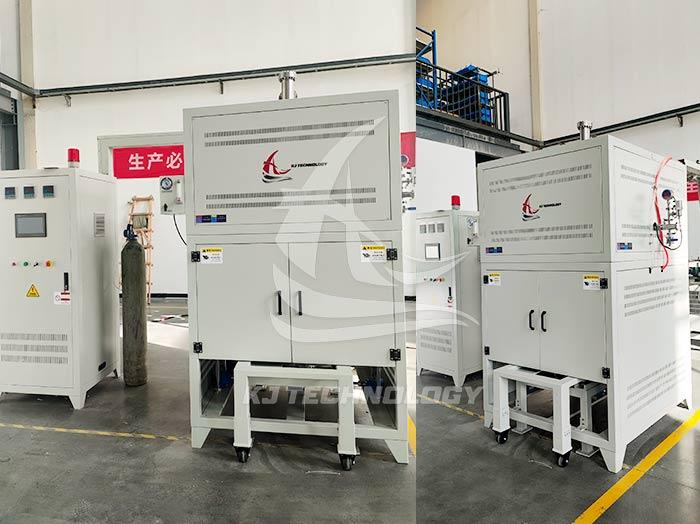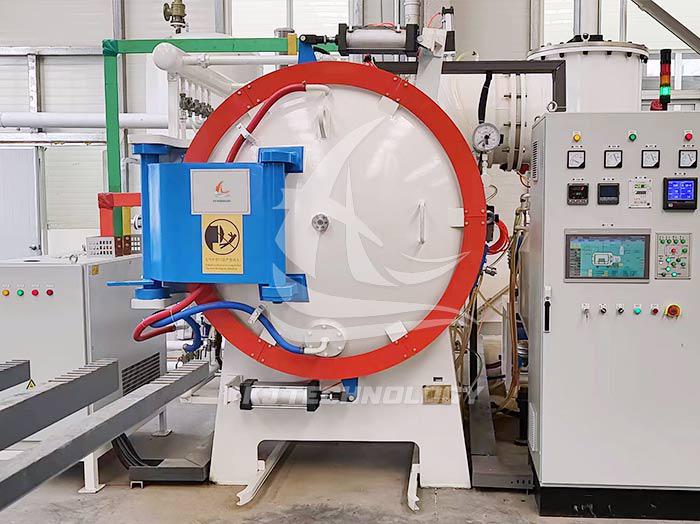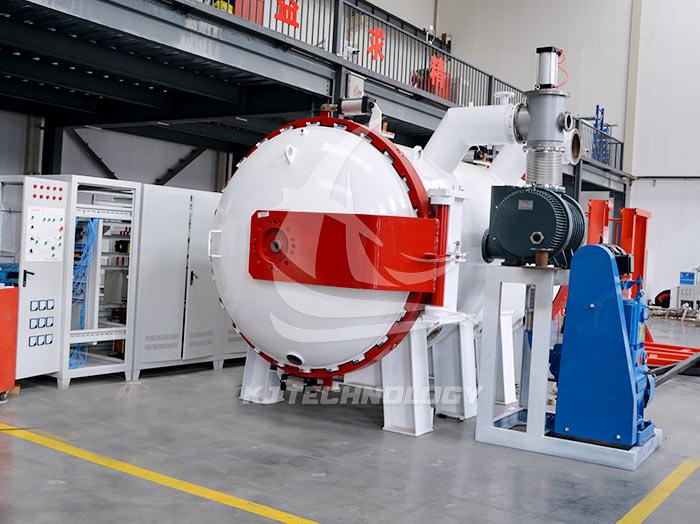Application of High Vacuum Hot Pressing Furnace in Metal Manufacturing Industry
 07-18-2025 Author: KJ technology
07-18-2025 Author: KJ technology
Although the application of high vacuum hot press furnaces in the metal manufacturing industry is not as extensive as in the ceramic field, they demonstrate unique advantages in precision part heat treatment, high-performance alloy preparation, and special metal processing through the synergistic effect of vacuum environment and pressure. The specific applications and values are as follows:
1. Core application scenarios
Heat treatment of precision metal parts
Case: A metal processing enterprise uses a vacuum hot press furnace to heat treat gear shafts. Through pulse carburizing technology under low-pressure vacuum (alternating strong infiltration and diffusion), combined with gas quenching (high-speed cooling with helium gas), the surface of the parts is free of oxidation and quenching oil residue. After processing, the surface of the parts appears as "earthy gold" color, with significantly improved smoothness and no intergranular oxidation in the metallographic structure. The fatigue resistance is improved by more than 30%, and the thermal deformation is reduced by 50% compared to traditional oil quenching.
Advantages: Vacuum environment eliminates oxide scale, reduces subsequent cleaning and shot blasting processes, and lowers labor intensity and production costs; Gas quenching ensures uniform cooling, avoiding thermal stress cracks caused by oil quenching, and improving the yield of parts.
Preparation of high-performance metal based composite materials
Application: Under vacuum hot pressing conditions, metal powders (such as titanium and aluminum) are combined with ceramic particles (such as silicon carbide and aluminum oxide) to promote metallurgical bonding between particles through pressure, forming high-strength and high wear resistant metal based composite materials. For example, titanium based titanium carbide (Ti TiC) composite materials are used for rocket engine casings, which improve fatigue resistance by 40% while reducing weight by 20%.
Principle: Vacuum environment eliminates gas impurities, pressure promotes particle plastic flow and diffusion, improves the interfacial bonding strength of composite materials, refines grain size to the nanometer level, and increases hardness by 25% -30%.
Densification sintering of refractory metals and alloys
Case: In the preparation of tungsten molybdenum alloy products (such as electrodes and nozzles), a vacuum hot pressing furnace works synergistically with high temperature (1600-2400 ℃) and pressure (10-50MPa) to rapidly densify the powder, achieving a relative density of over 99% and a porosity of less than 0.5%. Compared with normal pressure sintering, the sintering temperature is reduced by 200-400 ℃, the grain growth inhibition rate is increased by 50%, and the thermal conductivity of the product is increased by 15% -20%.
Advantages: Vacuum environment reduces the adsorption of volatile impurities (such as oxygen and nitrogen), pressure promotes an increase in the contact area between particles, reduces sintering driving force, and achieves rapid densification at low temperatures.
2. Analysis of Technical Advantages
Inhibit oxidation and impurity doping, improve material purity
The vacuum environment (pressure<10 ⁻ ² Pa) reduces gas molecule collisions, lowers the probability of metal reacting with oxygen and nitrogen, and results in a surface oxide layer thickness of<1 μ m and impurity content<0.01%, meeting the requirements for high purity materials in aerospace, semiconductor, and other fields.
Optimize microstructure and enhance mechanical performance
Pressure assisted sintering refines the grain size to the nanometer level (0.1-1 μ m), increases the grain boundary area by 30% -50%, increases the resistance to dislocation movement, increases material hardness by 20% -30%, and increases tensile strength by 15% -25%. For example, the aluminum based silicon carbide composite material prepared by vacuum hot pressing has a bending strength of 800 MPa, which is 1.5 times that of atmospheric pressure sintering.
Reduce sintering temperature and shorten process cycle
Pressure promotes material transfer between particles, reducing sintering temperature by 200-400 ℃ and shortening sintering time by 50% -70%. For example, the sintering temperature of tungsten alloy was reduced from 2300 ℃ to 1900 ℃, the sintering time was shortened from 10 hours to 3 hours, and energy consumption was reduced by 40%.
Realize complex shape forming and reduce post-processing
During the hot pressing process, the mold applies pressure to directly form shaped parts (such as turbine blades and bearing sleeves) with a dimensional accuracy of ± 0.05mm and a surface roughness Ra<0.8 μ m, reducing machining steps and lowering production costs by 20% -30%.
3. Typical application cases
aerospace field
A certain aerospace company uses a vacuum hot press furnace to prepare carbide based hard alloy cutting tools. After 10 minutes of hot press sintering at 2150 ℃, a material with a relative density of 99.2% and a hardness of 92HRA is obtained. It is used for processing difficult to cut materials such as titanium alloys and high-temperature alloys, and the tool life is increased by three times.
Automotive industry field
A certain automotive parts manufacturer uses a vacuum hot press furnace to produce aluminum alloy pistons. By using pressure assisted sintering to eliminate internal pores, the thermal expansion coefficient is reduced by 15% and the thermal conductivity is increased by 20%. It is suitable for high-performance engines, reduces the risk of detonation, and improves fuel efficiency by 5%.
In the field of electronics industry
A certain electronic enterprise uses a vacuum hot pressing furnace to prepare molybdenum target materials, which are sintered by hot pressing at 2200 ℃ to obtain target materials with grain size<5 μ m and density>99.5% for magnetron sputtering coating. The film uniformity is improved by 30% and the resistivity is reduced by 20%, meeting the requirements of high-frequency materials for 5G communication base stations.








